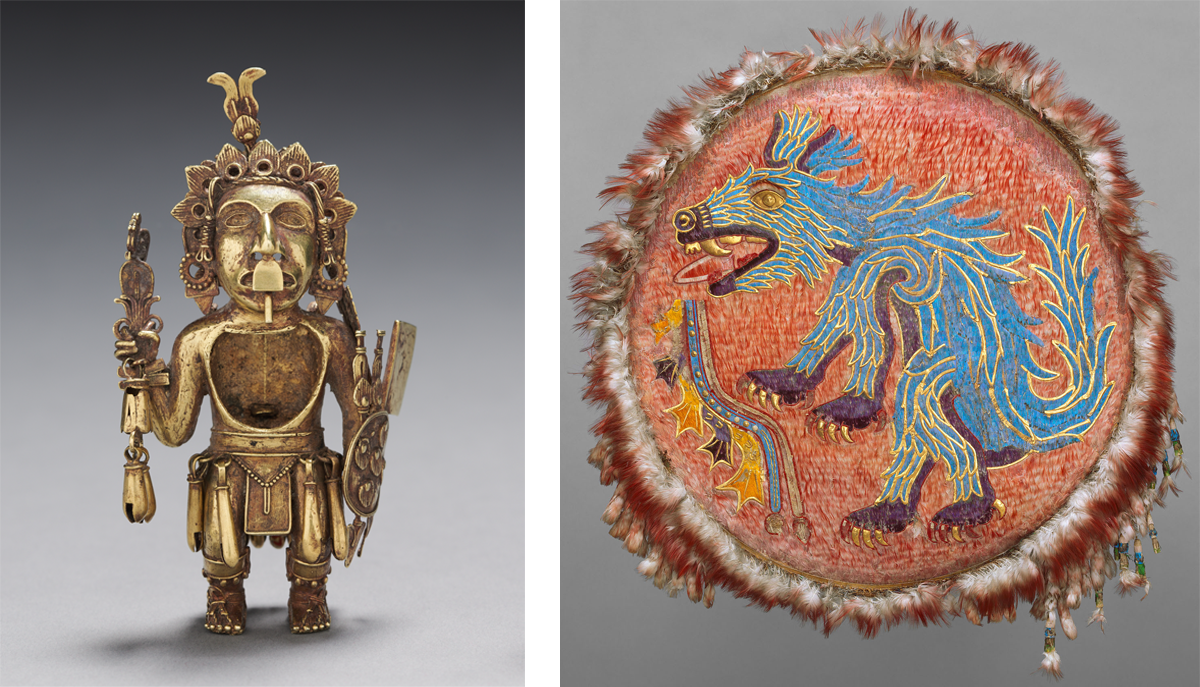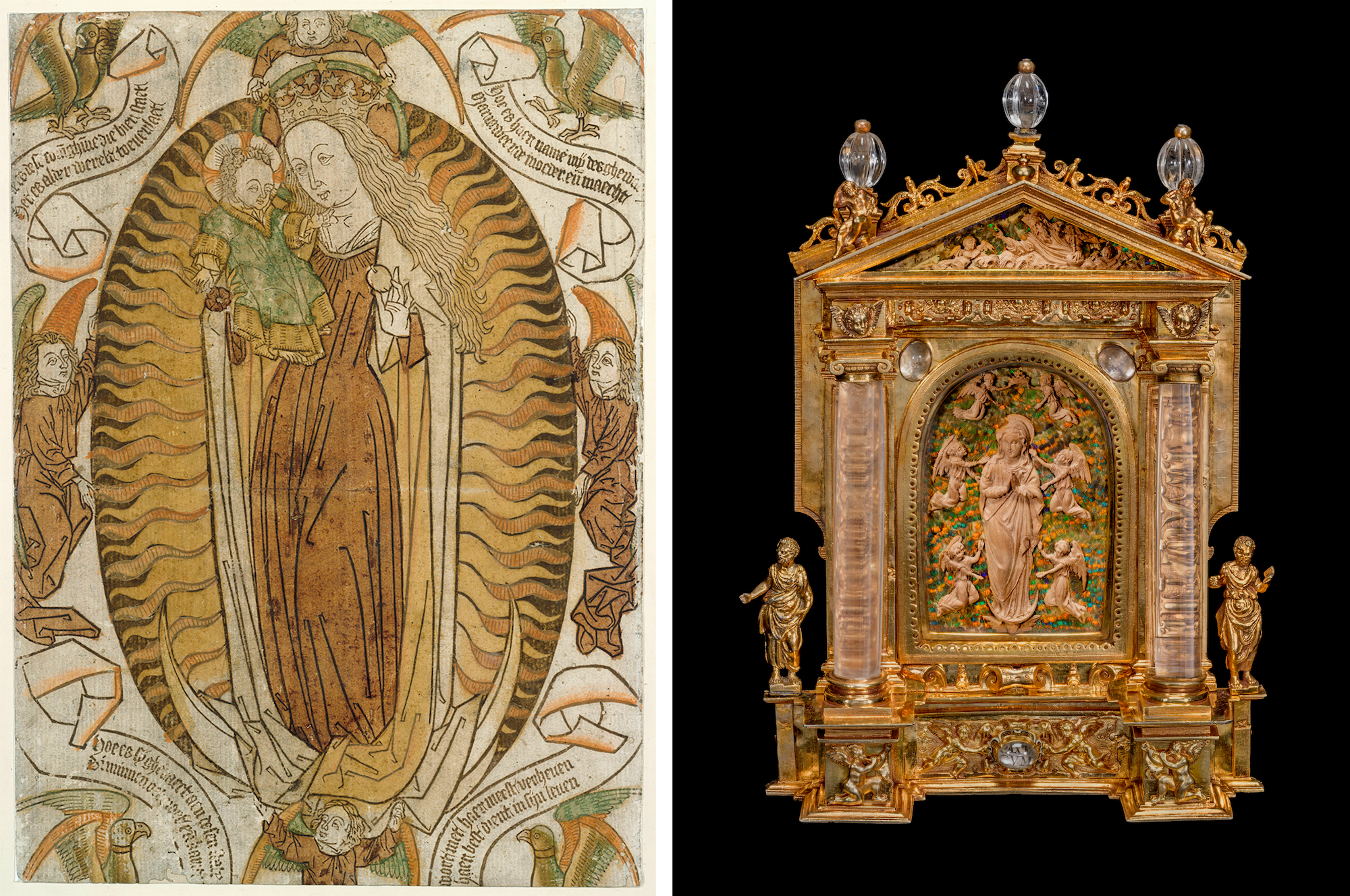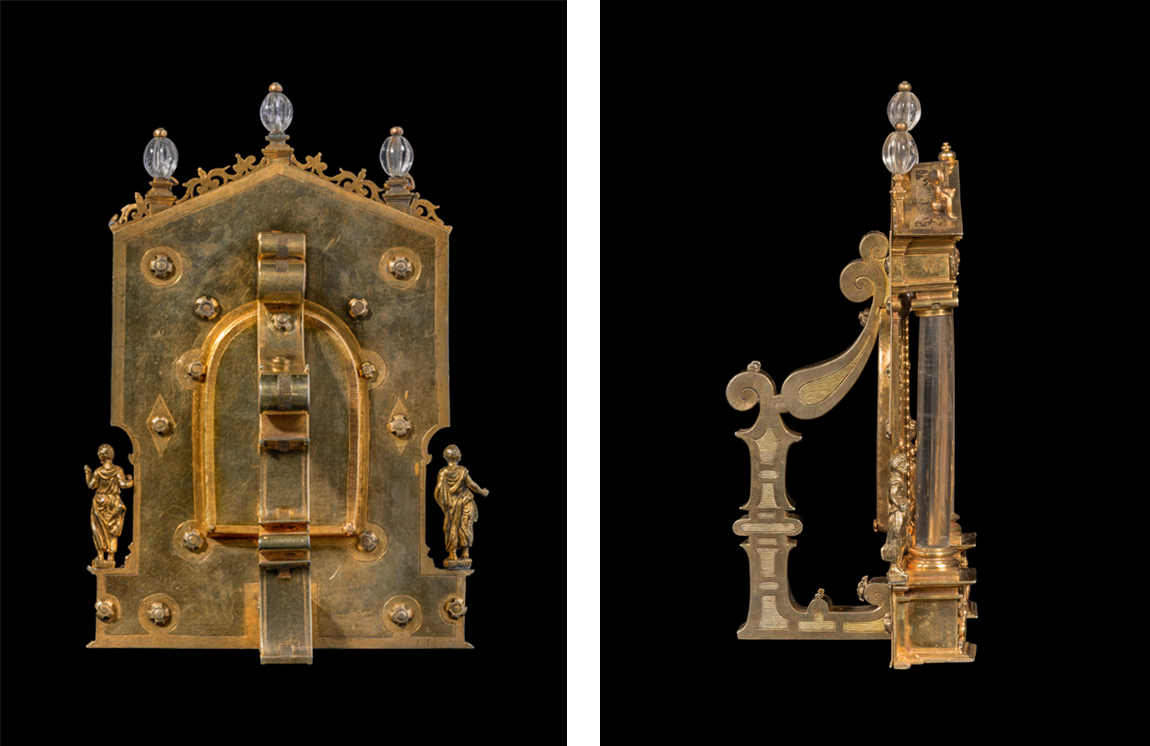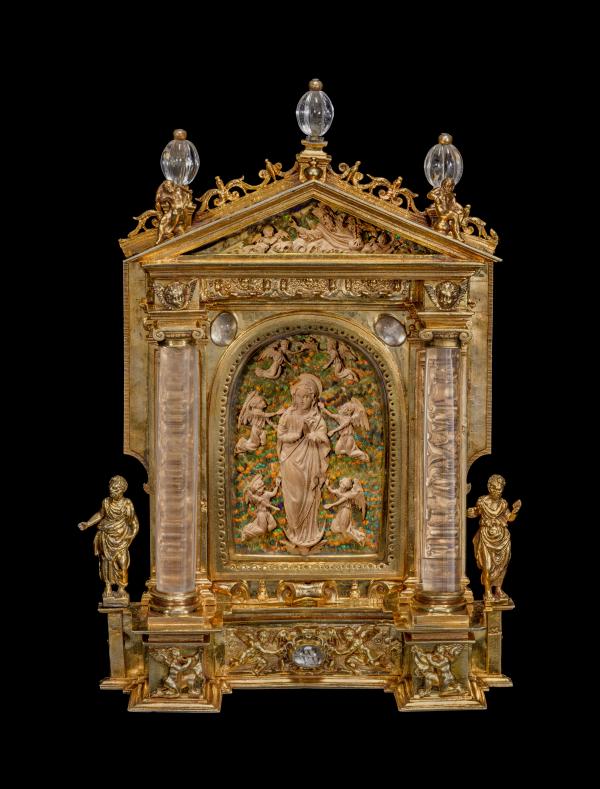This week we added a very special Spanish American object to the collection: an exquisite 16th-century Mexican pax. The pax was an object decorated with Christian subjects and used during the “kiss of peace” ritual. Carried by the priest, it was kissed by congregants at the end of Mass.
This remarkable example was created by Indigenous artists during the turbulent years after the conquest in the 1500s, likely in a school established by Flemish Franciscan missionaries to educate the Indigenous nobility. Around 1527, Friar Pedro de Gante (c. 1480/86–1572) established the famed school of San José de los Naturales next to the primary Franciscan monastery in Mexico City—San Francisco el Grande. There he trained the sons of the local Indigenous elite to read and write in Latin, in addition to teaching the basic tenets of the Christian faith. The school also became a major epicenter for the arts.

The pax combines precious metals, iridescent feathers, wood microcarvings, and rock crystal (quartz). Long used by local artists and invested with sacred meanings, these materials were redeployed in postconquest times to create Christian objects, demonstrating an important level of Indigenous agency and resilience under Spanish rule.
Conceived as a classical temple, the central image represents the coronation and assumption of the Virgin Mary flanked by a jubilant cohort of angels, while the tympanum includes a depiction of God the Father—all delicately carved in wood and set against a flickering feather background. Beautifully cast figures of Saints Peter and Paul guard the Virgin’s heavenly ascent, surrounded by lively cherubs. Rock crystal is used for the columns, finials, and cabochons, including one at the bottom with the Latin phrase “Peace be with you” (Pax Tecum).

The Franciscans ardently promoted images of the prayerful Virgin surrounded by sunbeams and riding on a crescent moon supported by an angel to emphasize her pure birth (what is known as the doctrine of the Immaculate Conception)—a hugely contested topic at the time. Prints like the one shown here circulated among learned clerics in Mexico City; they were used as artistic models and to indoctrinate the local population. Significantly, the same woodcut has also been widely acknowledged as a source behind the invention of the titular image of the Virgin of Guadalupe at the Basilica of Guadalupe, Mexico City. According to some scholars, this icon was painted by an Indigenous artist named Marcos who collaborated with the Franciscans and was active at the Convento Grande (Peterson, 2014). The pax’s careful interplay of the green, brown, and orange feathers suggests that the artists were attentive to the color scheme of this or similar woodcuts. The vibrant feathers are both a material and symbolic index of divine force used to animate the Marian image they envelope.

A striking aspect of the pax is the mix of precious materials and techniques. Before the arrival of the Spaniards, the Mexica (Aztecs) had an advanced tradition of metalwork. Religious wood microcarvings were introduced from the Netherlands by Flemish friars, and Indigenous artists quickly mastered and incorporated the technique into a number of different objects such as LACMA’s celebrated “Hearst” Chalice (Katzew, 2022), as well as small lantern-shaped pendants (beriles). Described by contemporaneous authors as “an impossible thing,” the Mexican works garnered much praise for their minute, intricate carvings.

Feathers, which also predated the Spaniards, were considered sacred and associated with sacrificial practices. Indigenous sources describe two major types of feathers: those believed to preserve the life force (tonalli) of special birds (known in Nahuatl as tlazohihhuitl, or “beloved birds”), which retained their intense glow and therefore required to be handled with utmost care; and those devoid of energiae or spiritual force (known as macehualihhuitl, or “commoner feathers”). Feather artists skillfully layered both kinds in their works to accentuate the shimmer of the tiny plumes of prized, exotic birds (Caplan, 2020). These feather mosaics were highly coveted and sent as gifts to rulers and religious authorities across the globe, who were mesmerized by their optical effect. The Franciscan friar Toribio de Benavente, known as Motolinía (c. 1490–1569), remarked in awe that “when seen from the front they look brownish, but when turned slightly they sometimes appear orange and at other times like the flame of fire” (Katzew and Kaplan, 2021).
Quartz, too, was revered in Mesoamerica due to its reflective qualities and its relationship to the sun. In Europe, the transparent and durable material was used in a range of liturgical objects. Linked to congealed water, crystal became a metaphor for the transformation of the Virgin and Christ from human to eternal and indestructible (Gerevini, 2014). The crystal columns set against intricate gold reliefs create the illusion of hardening water. This brilliant detail demonstrates the sophisticated workmanship of this unique artifact, which simultaneously exploits the magnifying properties of quartz and reflects the makers’ profound grasp of complex theological concepts.

Every detail, from the engraved decorations on the top and across the handle, and down to the last nut and bolt on the back, is brilliantly and precisely conceived.

The pax reflects an extraordinarily sophisticated understanding of the power of materials to bridge two symbolic universes. The Aztecs assigned great significance to the concept of preciousness (Berdan, 1992; Fane 2015). The contrast of radiant feathers, gold, and stones in ceremonial objects was thought to endow wearers with supernatural powers. Placed into Christian objects, the light cast by these glowing materials inspired wonder and induced piety. It is not difficult to imagine how, when the priest lifted the pax during the Mass, it glistened, channeling the spirit of the divine.
The excellent condition of the feathers suggests that the pax was not opened or exposed excessively to light, especially when compared to LACMA’s “Hearst” Chalice, which might have been created in the same workshop, a subject that I am currently researching. This is an extremely rare surviving early colonial object—and the only known one of its kind. Superbly crafted, it embodies an entirely new visual language between Europe and the Americas.
Acknowledgments
My most heartfelt thanks to my LACMA colleagues who, over the course of three long years, helped structure the acquisition and obtain the required permits to bring the pax to Los Angeles: Jeffrey Blair (former General Counsel & Assistant Secretary), Erika Franek (Director of Collections), Errin Copple (Head Registrar), and Linda Leckart (Registrar).
Provenance
The pax was in the collection of the German-born British financier and collector Leopold Hirsch (1858?–1932). It was subsequently acquired by the British dealer and proprietor of London’s Spanish Art Gallery Lionel Harris (1862–1943), Christie’s, London, 1934, and years later by the Swiss collector Richard Stern (1920–1991), Christie’s, Geneva, 1981. The work remained in the same family in Geneva before it was accessioned by LACMA (via Christie’s, London) through the generosity of the 2024 Collectors Committee.
During our 38th annual Collectors Committee Weekend (April 27–28, 2024), members of LACMA's Collectors Committee generously helped the museum acquire 10 works of art spanning a breadth of eras and cultures. Read more about all the acquisitions.
Selected Reading
Berdan, Frances F. “Economic Dimensions of Precious Metals, Stones, and Feathers: The Aztec State Society.” Estudios de cultura náhuatl 22 (1992): 291–323.
Caplan, Allison. “The Living Feather: Tonalli in Nahua Feather Production.” Ethnohistory 67, no, 3 (2020): 383–407.
Fane, Diana. “Feathers, Jade, Turquoise, and Gold.” In Images Take Flight: Feather Art in Mexico and Europe, 1400–1700, edited by Alessandra Russo, Gerhard Wolf, and Diana Fane, 101–16. Munich: Hirmer, 2015.
Gerevini, Stevania. “Chrystus crystallus: Rock Crystal, Theology, and Materiality in the Medieval West.” In Matter of Faith: An Interdisciplinary Study of Relics and Relic Veneration in the Medieval Period, edited by James Robinson and Lloyd de Beer, with Anna Harden, 92–99. London: British Museum, 2014.
Katzew, Ilona, ed. Archive of the World: Art and Imagination in Spanish America, 1500–1800; Highlights from LACMA’s Collection. Exh. Cat. Los Angeles: Los Angeles County Museum of Art; New York: DelMonico Books/D.A.P., 2022, cat. 15.
Katzew, Ilona, and Rachel Kaplan. “‘Like the Flame of Fire’: A New Look at the ‘Hearst’ Chalice.” Latin American and Latinx Visual Culture 3, no. 1 (2021): 4–29.
https://online.ucpress.edu/lalvc/article/3/1/4/116185/Like-the-Flame-of-Fire-A-New-Look-at-the-Hearst
Peterson, Jeanette Favrot. Visualizing Guadalupe: From Black Madonna to Queen of the Americas. Austin: University of Texas Press, 2014, chap. 4.



